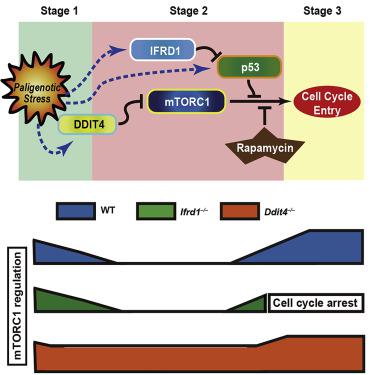Developmental Cell ( IF 10.7 ) Pub Date : 2020-08-07 , DOI: 10.1016/j.devcel.2020.07.005 Zhi-Feng Miao 1 , Mark A Lewis 2 , Charles J Cho 2 , Mahliyah Adkins-Threats 2 , Dongkook Park 2 , Jeffrey W Brown 2 , Jing-Xu Sun 1 , Joseph R Burclaff 2 , Susan Kennedy 2 , Jianyun Lu 2 , Marcus Mahar 3 , Ilja Vietor 4 , Lukas A Huber 4 , Nicholas O Davidson 5 , Valeria Cavalli 3 , Deborah C Rubin 5 , Zhen-Ning Wang 6 , Jason C Mills 7

|
Differentiated cells can re-enter the cell cycle to repair tissue damage via a series of discrete morphological and molecular stages coordinated by the cellular energetics regulator mTORC1. We previously proposed the term “paligenosis” to describe this conserved cellular regeneration program. Here, we detail a molecular network regulating mTORC1 during paligenosis in both mouse pancreatic acinar and gastric chief cells. DDIT4 initially suppresses mTORC1 to induce autodegradation of differentiated cell components and damaged organelles. Later in paligenosis, IFRD1 suppresses p53 accumulation. Ifrd1−/− cells do not complete paligenosis because persistent p53 prevents mTORC1 reactivation and cell proliferation. Ddit4−/− cells never suppress mTORC1 and bypass the IFRD1 checkpoint on proliferation. Previous reports and our current data implicate DDIT4/IFRD1 in governing paligenosis in multiple organs and species. Thus, we propose that an evolutionarily conserved, dedicated molecular network has evolved to allow differentiated cells to re-enter the cell cycle (i.e., undergo paligenosis) after tissue injury.
Video Abstract
Download : Download video (47MB)
中文翻译:

专用的进化保守分子网络许可分化的细胞返回细胞周期。
分化的细胞可以通过一系列由细胞能量调节器 mTORC1 协调的离散形态和分子阶段重新进入细胞周期以修复组织损伤。我们之前提出了术语“paligenosis”来描述这种保守的细胞再生程序。在这里,我们详细介绍了在小鼠胰腺腺泡和胃主细胞的 paligenosis 期间调节 mTORC1 的分子网络。DDIT4 最初抑制 mTORC1 以诱导分化细胞成分和受损细胞器的自降解。在 paligenosis 的后期,IFRD1 抑制 p53 的积累。Ifrd1 -/-细胞不会完成 paligenosis,因为持久的 p53 阻止 mTORC1 再激活和细胞增殖。Ddit4 -/-细胞从不抑制 mTORC1 并绕过 IFRD1 增殖检查点。以前的报告和我们目前的数据表明 DDIT4/IFRD1 可以控制多个器官和物种的苍白病。因此,我们提出进化上保守的、专用的分子网络已经进化到允许分化的细胞在组织损伤后重新进入细胞周期(即,经历paligenosis)。
视频摘要
下载 :下载视频 (47MB)











































 京公网安备 11010802027423号
京公网安备 11010802027423号